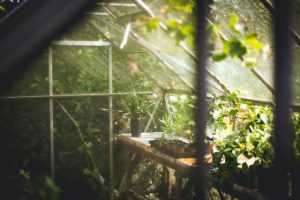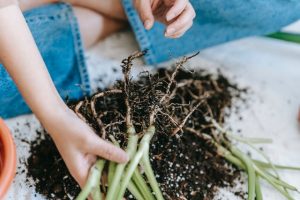A garden greenhouse allows the gardener to create a microclimate for growing crops in any season. Thus, you can cultivate sheltered from climatic hazards thanks to a greenhouse while offering ideal growing conditions to your plantations.
The garden greenhouse must be adapted to your use: size, structure, glazing, equipment must be chosen carefully according to your projects. Then, it remains to associate light, heat, humidity, and ventilation to create a comfortable and flexible space to adapt to the seasons.
What type of greenhouse should I choose?
The first function of a greenhouse is to create a kind of microclimate for frost-sensitive plants, seedlings and early crops, and annual plants. Its principle is to capture the sun’s heat during the day and release it at night during cold periods. The different shapes of greenhouses allow satisfying all the needs.
The traditional greenhouse, fixed and perennial…
In the garden, the traditional greenhouse is a very aesthetic space of nature and is a decorative element in its own right. So fixed, it has the shape of a small house and can accommodate all kinds of plantations. This garden greenhouse made of glass or polycarbonate offers an important luminosity and can be installed perennially. It is advisable to provide shading for the hottest periods.
The tunnel greenhouse, ideal for large areas…
The tunnel greenhouse is made of large steel or galvanized steel hoops on which a flexible plastic film is stretched. The greater the thickness of the hoops (minimum 1.5 mm), the more resistant they are. The inclination of the walls optimizes the penetration of light and sun rays. The tunnel greenhouse can be equipped with hinged doors or ventilation systems at each end. Depending on their height, the width of the doors can be variable and thus allow working with small cultivators.
The tunnel greenhouse offers the advantage of being easy to assemble and disassemble and economical. It allows creating a large surface of the culture quickly. It is used for early crops or vegetable growing (market gardening). However, its fragility (lack of wind resistance) and its less aesthetic aspect can be disadvantaged.
For a huge greenhouse, discover the models of vegetable greenhouses, offering a very comfortable volume for the gardener’s work.
The lean-to greenhouse or wall greenhouse…
The lean-to greenhouse is installed against a wall. Even if placed in an area that is not suitable for growing plants, the lean-to greenhouse has the advantage of storing heat better than a greenhouse that is open to the wind. This type of greenhouse can be installed on a balcony or terrace and used as a winter greenhouse.
The balcony greenhouse or mini garden greenhouse…
The balcony greenhouse or small garden greenhouse is mainly used for sowing seeds, shelter plants from frost in winter, or grow aromatic or vegetable plants. It comes in the form of a small greenhouse with a steel or wooden structure. It is sold with its transparent cover and a protective cover for the winter.
The frame greenhouse, for sowing and forcing…
The frame greenhouse is a kind of mini-greenhouse that is particularly suitable for sowing and forcing young plants and vegetables from the beginning of spring before transplanting them into the ground. The frame consists of a wooden box on which is fixed a glass.
The tomato greenhouse…
The tomato greenhouse is invaluable for tomato plants, which like heat and appreciate regular watering. It takes the form of a greenhouse under hoops whose protective film does not reach the ground. This allows for optimal ventilation, limiting any excess heat while protecting the plants from bad weather. Tomatoes can be grown in pots or beds, but the seeds must be sown at 19°C, from the end of winter to the beginning of spring.
Which greenhouse for which use?
•For an early vegetable garden, we choose a greenhouse-type frame that allows young plants’ forcing and protects the seedlings from rain and night frosts. To grow a wider range of vegetable varieties, the greenhouse should be heated to 4 or 5°C.
•To overwinter plants, it is advisable to choose a greenhouse large enough to accommodate all fragile potted plants such as oleanders, geraniums, or citrus. Depending on the region, it is necessary to protect the plants from freezing with a heating system to keep the temperature above 0°C. If it is not heated, it must be equipped with a protective cover during the winter period.
•To house rare or tropical plants, it is necessary to place them in a traditional greenhouse made of thick glass or double-walled polycarbonate, heated to a minimum of 18°C.
Cold greenhouse, hot greenhouse: which heating for your greenhouse?
We distinguish between cold, temperate, and hot greenhouses, depending on the crops grown.
•The cold greenhouse is not heated, and temperatures can be negative. It allows you to be a few weeks ahead of the seasonal periods but should be reserved for hardy species.
•The temperate greenhouse is equipped with a heater, which maintains a temperature above 5°C. Thus, it allows the early cultivation of plants sensitive to frost.
•The warm greenhouse is equipped with a heater and insulation, making it possible to maintain a temperature adapted to tropical plants.
• To heat your greenhouse, electric heaters with thermostat or specific heating cables can be used. The heating must be adapted to the size of the greenhouse.
Installation of a greenhouse and regulations.
The installation of a greenhouse must be done according to the rules and is – like any construction – subject to the municipality’s local urban plan (PLU). It is therefore important to bear in mind that :
•Garden greenhouses with a surface area of less than 2 m² are not subject to any regulations.
•Greenhouses with a surface area between 2 m² and 20 m² require a prior declaration of works.
•Greenhouses with a floor area of more than 20 m² require a building permit.
In any case, whatever the surface of the greenhouse, it is necessary to get information from the town hall because some areas may be classified and be subject to special provisions.



